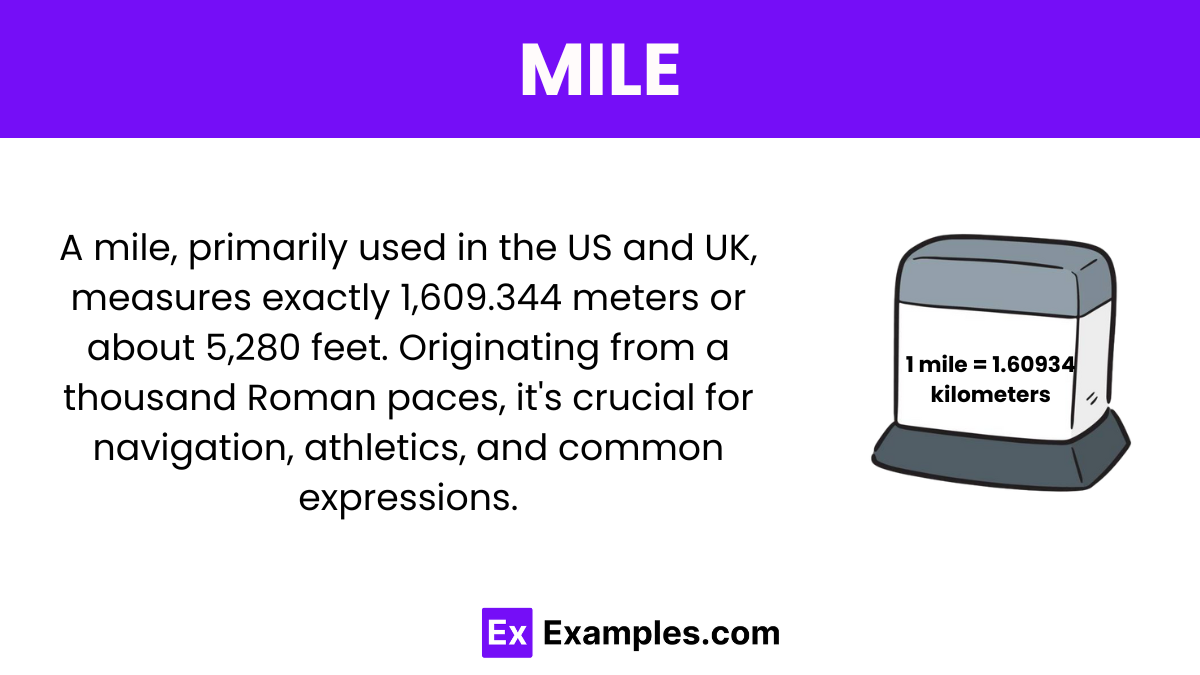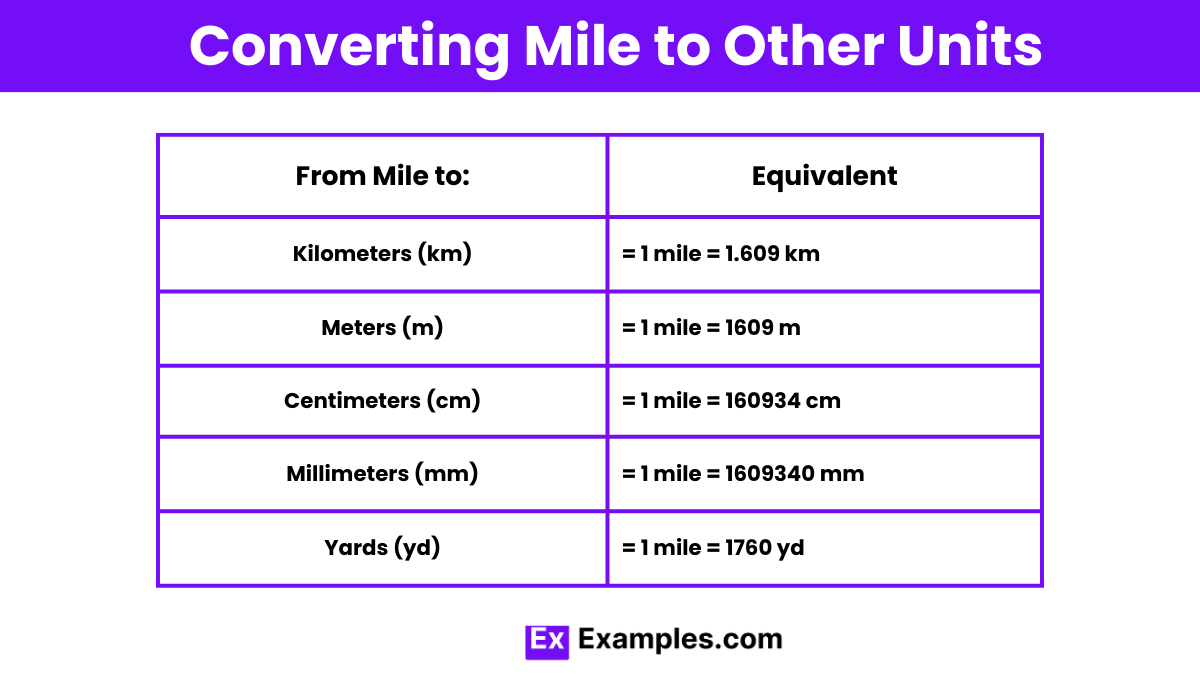If a car travels 60 miles in 1.5 hours, what is its average speed in miles per hour?
30
40
50
60


The mile, a unit of length often taken for granted, holds a rich tapestry of history and significance beyond mere measurement. Originating from the Roman “mille passus,” or a thousand paces, this ancient measure has evolved through cultures and epochs to anchor itself in both everyday use and scientific calculation. Today, it remains a cornerstone in sports, travel, and cultural expressions across the globe, embodying both a physical distance and a metaphor for significant achievements in human endeavours.
A mile is a unit of length predominantly used in the United States and the United Kingdom. It is defined as exactly 1,609.344 meters or about 5,280 feet. Historically derived from the length of a thousand Roman paces, the mile today is integral to navigation, athletics, and colloquial expressions. This measurement continues to play a vital role in road signage, distance tracking, and represents significant strides in various achievements and journeys.

Measuring distance accurately is crucial in many fields such as surveying, navigation, sports, and more. Here are eight tools commonly used to measure a mile:
These tools offer different levels of accuracy and are suited for various contexts, from simple everyday tasks to professional applications.

Below is a table that demonstrates how to convert a mile into various other units of length. This conversion table can be very helpful for a wide range of activities, from educational purposes to practical applications in science, engineering, and daily life.
| From Mile to: | Equivalent |
|---|---|
| Kilometers (km) | 1 mile ≈ 1.609 km |
| Meters (m) | 1 mile ≈ 1609 m |
| Centimeters (cm) | 1 mile ≈ 160934 cm |
| Millimeters (mm) | 1 mile ≈ 1609340 mm |
| Yards (yd) | 1 mile ≈ 1760 yd |
| Feet (ft) | 1 mile ≈ 5280 ft |
| Inches (in) | 1 mile ≈ 63360 in |
| Nautical Miles (nmi) | 1 mile ≈ 0.869 nmi |
This table provides an easy reference for converting miles to other common units of length, using the most accurate conversion factors available.
Here are the conversions from miles to various other units of length, formatted for clear and consistent understanding:
1 mile = 1.60934 kilometers.
To convert miles to kilometers, multiply the mile value by 1.60934.
Example: 2 mi is 2 x 1.60934 = 3.21868 km.
1 mile = 1,609.34 meters.
Multiply the mile value by 1,609.34 to convert to meters.
Example: 3 mi equals 3 x 1,609.34 = 4,828.02 meters.
1 mile = 160,934 centimeters.
Multiply the mile value by 160,934 to convert to centimeters.
Example: 0.5 mi is 0.5 x 160,934 = 80,467 cm.
1 mile = 1,609,340 millimeters.
Multiply the mile value by 1,609,340 to convert to millimeters.
Example: 1.5 mi is 1.5 x 1,609,340 = 2,414,010 mm.
1 mile = 1,760 yards.
Multiply the mile value by 1,760 to convert to yard.
Example: 4 mi is 4 x 1,760 = 7,040 yards.
1 mile = 5,280 feet.
Multiply the mile value by 5,280 to convert to feet.
Example: 7 mi equals 7 x 5,280 = 36,960 feet.
1 mile = 63,360 inches.
Multiply the mile value by 63,360 to convert to inches.
Example: 1 mi is 1 x 63,360 = 63,360 inches.
1 mile = 0.868976 nautical miles.
Multiply the mile value by 0.868976 to convert to nautical miles.
Example: 6 mi is 6 x 0.868976 = 5.213856 nautical miles.
These conversions help in understanding how distances measured in miles can be expressed in various other units, useful across different contexts and applications

The mile is a versatile unit of measurement used in many different contexts around the world, despite the widespread adoption of the metric system. Here are some of the primary uses of the mile:
These diverse uses demonstrate the mile’s continued relevance in modern society across various domains, from everyday life to technical fields.
Another word for “mile” is “statute mile,” which is the official term used to specify the standard mile measurement of 5,280 feet, especially when distinguishing it from the nautical mile used in aviation and maritime contexts. “Statute mile” emphasizes its legal basis in measurements used for land distances.
The mile was redefined in 1593 during the reign of Queen Elizabeth I to harmonize the measurement with the furlong, a unit used in agriculture. Since there are 8 furlongs in a mile, and each furlong was defined as 660 feet, the mile was standardized to 5280 feet (8 x 660).
Visualizing a mile can vary based on context: it’s approximately 17.6 laps around a standard running track or just a bit less than the length of 15 football fields laid end to end. In urban settings, a mile might cover several city blocks, roughly equivalent to walking from one subway station to another.
In slang, “mile” often doesn’t refer to its literal measurement. For instance, “country mile” implies a long, seemingly endless distance, often used to exaggerate the effort or time taken to travel somewhere rural or remote, emphasizing more of an emotional distance than a physical one.
The time it takes to walk a mile can vary significantly based on a person’s age, fitness level, pace, and terrain. On average, it takes about 15 to 20 minutes to walk a mile on a flat and even surface at a moderate pace without any interruptions or significant physical obstacles.
Text prompt
Add Tone
10 Examples of Public speaking
20 Examples of Gas lighting
If a car travels 60 miles in 1.5 hours, what is its average speed in miles per hour?
30
40
50
60
How many feet are there in one mile?
4,840 feet
5,280 feet
5,000 feet
6,000 feet
If you run 3 miles, how many feet have you run?
15,840 feet
10,560 feet
16,000 feet
14,000 feet
If you drive 10 miles, how many yards have you traveled?
17,600 yards
18,000 yards
17,800 yards
17,400 yards
How many inches are there in a mile?
63,360 inches
62,360 inches
64,360 inches
60,360 inches
How many kilometers are in a mile?
1.2 kilometers
1.6 kilometers
2 kilometers
1.4 kilometers
How many miles are in 3,520 yards?
1 mile
1.5 mile
2.5 miles
2 miles
A car travels at 60 miles per hour. How many feet does it travel in one hour?
316,800 feet
318,000 feet
320,000 feet
315,000 feet
How many miles are in 21,120 feet?
3 miles
4 miles
5 miles
6 miles
A train travels 300 miles in 5 hours. What is its average speed in miles per hour?
50
55
60
65
Before you leave, take our quick quiz to enhance your learning!

